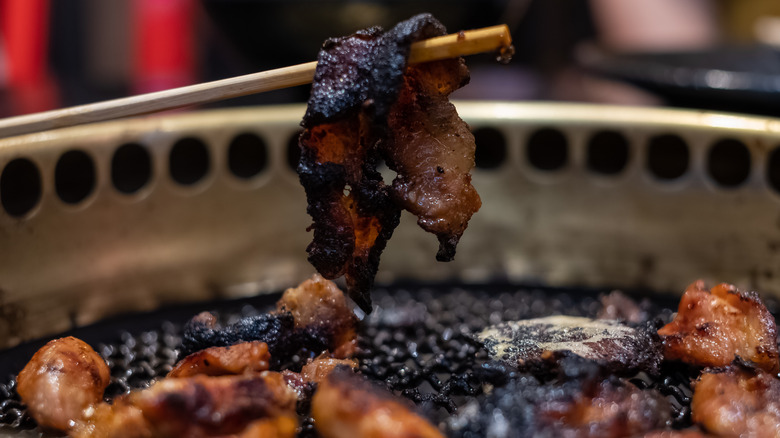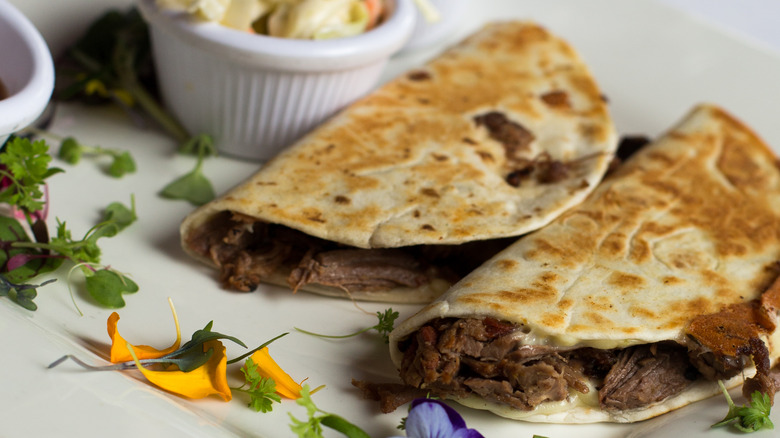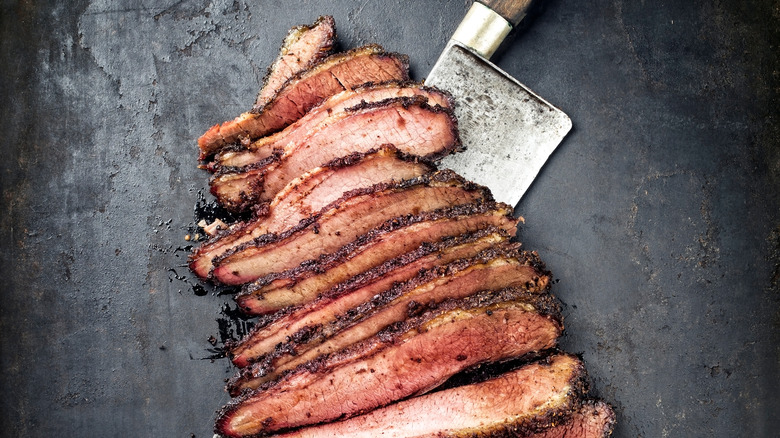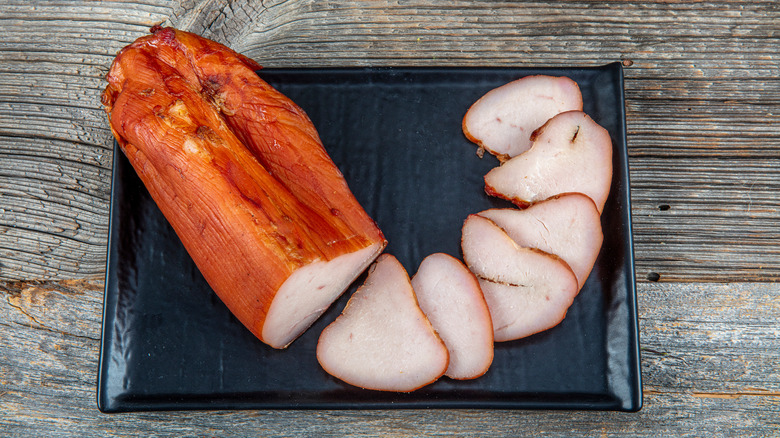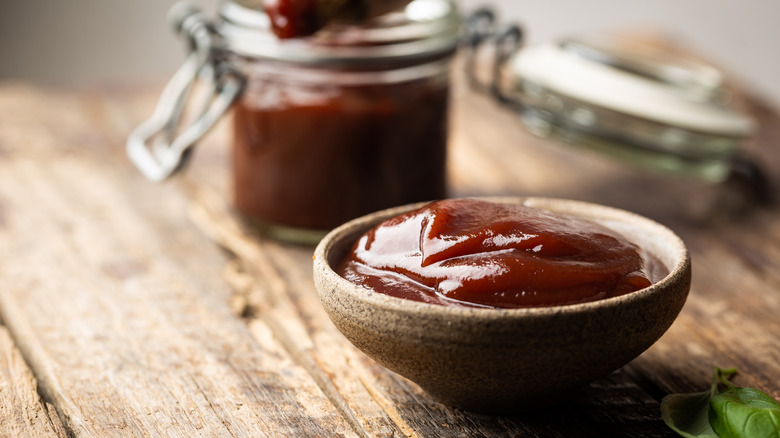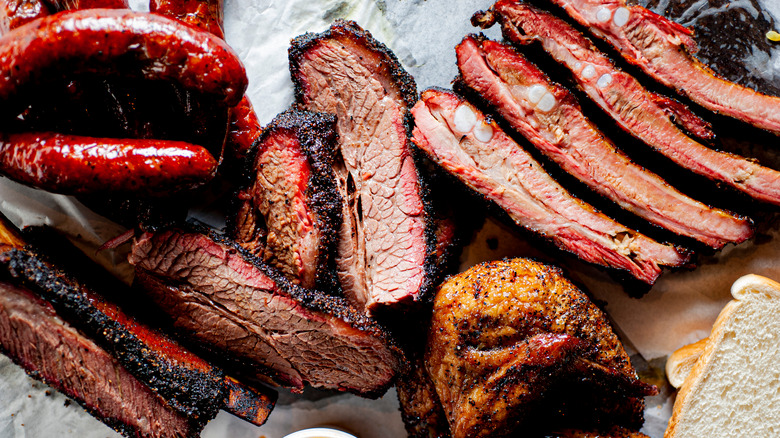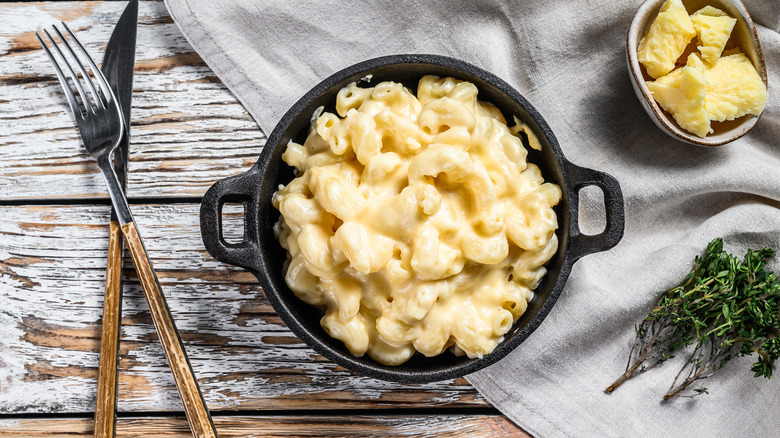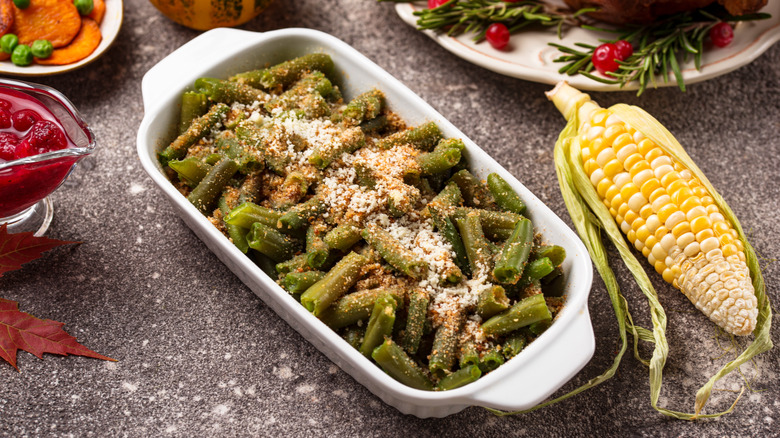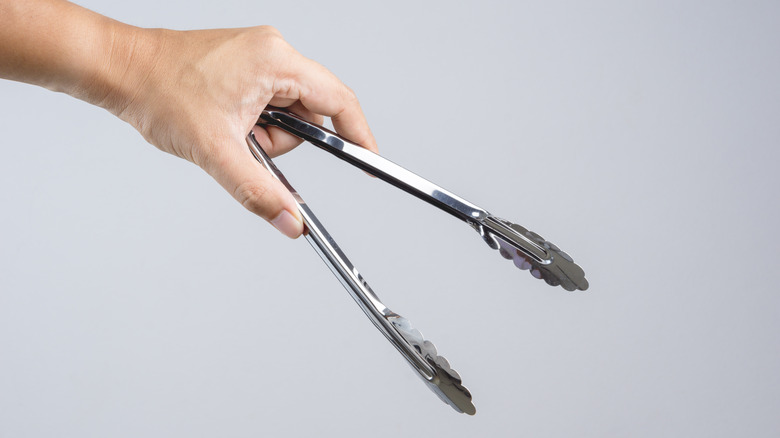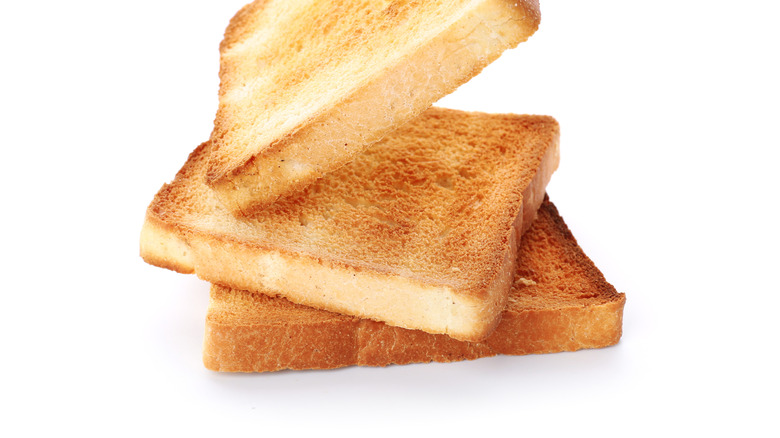10 Things You Should Never Order At A Barbecue Restaurant
Barbecue is beloved in many parts of the United States. And, much like its fellow American culinary classic of pizza, even when barbecue is kind of bad it's still pretty good. But it is still possible to go wrong when you're placing an order at a barbecue restaurant? Yes, the truth is that you can definitely end up with some dried-out pulled pork or even yesterday's brisket, but if you're visiting top-notch barbecue spots, that's not really your concern. Your biggest potential problem: that pernicious FOMO when you realize that you didn't order the absolute best thing on the menu.
You probably have a lot of options to choose from when you visit the barbecue counter, to the point where it's downright dizzying. And sometimes it's tough to know what your best options are. You might get dazzled by the sides, free garnishes, even fusion dishes or burgers on the menu, but don't forget that you're really there for the meat. That is arguably the heart and soul of barbecue, after all.
You might enjoy it when barbecue restaurants mix up their offerings, but before you branch out, do yourself a solid and try the basics. And be sure to do your research before you visit the restaurant to find out what their specialties are, or just ask at the counter when you get to the restaurant. Just know that there are some things to always avoid. These are 10 things you should never order at a barbecue restaurant.
Fusion dishes featuring barbecue meats
If you've had a fusion barbecue dish, you know they can be tasty and often creative. Pulled pork mac and cheese, brisket tacos, smoked turkey enchiladas, and barbecue quesadillas, just to name a few, can be a potential delight for your tastebuds. They can offer the flavors of barbecue with a little something else.
There's no denying there are good examples of barbecue fusion cuisine. But if you're stopping by a barbecue restaurant to try the meat, a fusion dish still probably isn't your best option. While it's possible they're made from fresh meat, First We Feast warns that it's also possible they're made from leftover meat that wasn't sold from the day before. Fusion dishes might also utilize trimmings of meat from that day that didn't make the cut for regular barbecue plates.
So, what's your best bet if you're interested in these dishes? Feel free to try them out — you may be pleasantly surprised — but maybe order them as a side instead. Ultimately, don't plan on making a fusion dish your main meal, especially if you're visiting a new barbecue spot for the first time.
Anything at the end of service hours
There's a reason barbecue lovers line up in the early morning hours to get the best barbecue. Towards the end of service hours, you might not be impressed by what's left. That's not to say you'll face bad barbecue at the end of the day, exactly. But earlier in the day, you'll certainly have a better selection. Later, you'll have to pick from what's left, which is generally what other people decided they didn't want to order. I
Remember that it often takes hours to barbecue and restaurants generally don't barbecue all day. Instead, they usually start at night or early in the morning and make all the meat they'll plan to serve for the day. When it's gone, it's really gone and you'll have to come back another day if you want something that's been extra popular.
Want to ensure the best selection? Arrive early. Yes, it may take some extra planning and a bit of determination, but you'll be glad that you showed up promptly. At some extremely popular barbecue restaurants, the reality is that you'll need to arrive hours before you actually plan to eat. Female Foodie reports that Franklin Barbeque in Austin, Texas is so incredibly popular that you might want to arrive as early as 6 or 7 in the morning if you want to eat around lunchtime and get your pick of the best meats. If your local spot is as sought-after, be sure to plan ahead.
Shaped meats
Smoked sausage is one thing, as most barbecue joints have at least one variety and it's a good idea to try it out. But shaped meats are something else entirely – and they're frankly best left at the deli counter. Generally speaking, when you're eating great barbecue, it's practically always from straight-off-the-animal primal meat cuts such as brisket, pork loin, ribs, or turkey breast.
Formed meat products take parts of meat, like trimmings and less desirable cuts, and then shape it all together into one piece. Sometimes, that's inside a casing, then sliced. Sometimes, whole cuts are smoked and thinly sliced like deli meats, though it's important to note that this technique is different than that used to make shaped meats.
While trying out some shaped meat at a barbecue spot could be tasty and a departure from the norm of deli meats, this isn't where barbecue really shines. As with fusion options, this might be worth a try in the right places, but at least make sure it's not the only thing on your plate. Otherwise, you might feel like you've missed out on trying the best at a great barbecue spot.
Barbecue sauce when you're in Texas
Barbecue sauce can be a regional thing. In some parts of the U.S., barbecue restaurants are even rated based on the quality of their sauces. There are certainly regional styles of barbecue sauce to partake in, too, per Taste of Home. Kansas City-style sauce is what many people think of as traditional barbecue sauce with a tomato base and sugar or molasses to round out the acidity. Meanwhile, the Carolinas are known for tangier, typically vinegar-based sauces.
But barbecue sauce isn't a major attraction everywhere, and in fact, it can be somewhat offensive to use in some parts of the country. For example, in Texas, it's considered an insult to the pitmaster if you add barbecue sauce to a perfectly smoked brisket. The thinking here is that the unique Texas barbecue style speaks for itself. If a pitmaster has done their job right, the meat is already perfect and adding sauce on top only takes away from the classic smoky flavor. However, it's not unusual for pitmasters to use barbecue sauce as they cook, adding it as a base or marinade. It just may be frowned upon to use it as a condiment once the meat makes it to your plate.
The wrong regional specialty
It's safe to say that barbecue specialties have many variations across the United States. What's popular and masterful in one region may not be what's typically sought after and perfected in another. In the Carolinas, it would be a mistake to skip out on whole-hog pork. Meanwhile, in Memphis and St. Louis, you don't sleep on the ribs. And in Texas, you've simply got to try the brisket. Of course, Kansas City does a little bit of everything, with a classic sauce added to it all, of course.
That said, while you might find a beautiful brisket in the Carolinas, or a great rack of ribs in Texas, don't make it your first order. At least initially, do a bit of research and look for the regional specialty to see what the barbecue restaurant in question should be able to do best, then go from there. You might even ask what their best dish is, order that, and add on other meats — just as long as you don't skip out on ordering the best of the best.
Heavy sides – especially fried things
Most people don't visit a barbecue restaurant thinking they're going to be eating healthy food, to be sure. However, at the same time, you want to avoid overdoing it. A barbecue plate loaded with meats and sides can feel like a delightful mini buffet, but exercise caution lest your eating experience goes awry. A lot of those classic barbecue sides can be really heavy, and if you're going to try them all, they can really start to add up and make you feel uncomfortably full. You may even feel too full to enjoy the meat that you really came for.
A barbecue plate with all meat and no sides isn't appealing to everyone, of course. Just remember that you need to choose your sides wisely. Maybe instead of fried okra, pick up some lighter vinegar-based coleslaw. Perhaps some classic collard greens would work well here, too. Or you can always limit how much you actually eat. Consider also how different ingredients may treat you. Beans might not seem like much sitting there on your plate, but the fiber will fill you up fast and make it difficult to focus on the meat.
Green beans – or most vegetables
Maybe, thinking about how that mac and cheese could get in the way of chowing down a good brisket, you're now looking for a lighter side to pair with your barbecue. If green beans are on the menu, that could seem like they fit the bill. But there's usually a reason most barbecue restaurants don't have a lot of vegetables available as sides: they're just not the best offering on the menu. In fact, Insider reports that green beans may even come from a can in some places. The same goes for the seemingly simple corn on the cob.
You might enjoy them and appreciate it as you eat barbecue, but most likely, vegetables at a barbecue restaurant aren't going to be anything special. And generally, if they're tasty in the world of barbecue, they're going to be pretty loaded with butter, bacon, and other stuff that tastes great but isn't exactly doing your health any favors. So if you were thinking you'd be saving calories picking something green, think again.
There are exceptions, of course. If a barbecue restaurant is known for a particular veggie side — like, say, some barbecue creamed corn or really excellent fried okra — or if they use ultra-fresh, local vegetables, you may be pleasantly surprised. But for the most part, if you're ordering vegetables at a barbecue spot, prepare to be disappointed.
Hamburgers
Pitmasters know meat, right? So it makes sense that they could knock it out of the park with a hamburger any day of the week. But that's not really their specialty and you'll probably be better off ordering something from the proper barbecue meat menu.
At a barbecue restaurant, the real talent lies in primal cut meat, not ground beef. Typically, burgers are often on the menu to offer an alternative to guests who aren't into barbecue but have somehow found themselves looking for a meal inside a barbecue joint. This could well mean that the restaurant's heart isn't really in this particular dish. If you're still craving a sandwich, most restaurants offer fresh chopped or sliced meat sandwiches that could fit the bill pretty well while still drawing on their central offering of barbecued meat.
That said, there are some barbecue restaurants where hamburgers are a specialty. Though rare, some offer a smoked burger, like the Smokehouse Burger at Tejas Chocolate & Barbecue in Tomball, Texas (via Houston Chronicle). It's key to note that the patty there is formed from ground brisket and smoked for 45 minutes before they're seared on a griddle. A good smoked burger like this can be a unique culinary experience when done right and with care (and the right kind of meat). But the truth is that most barbecue spots don't have the griddles needed to execute it well.
Pre-sliced meat
If you walk into a barbecue restaurant and see tongs and steamer baskets filled with meat, the sad truth is that you should probably just turn around and walk away. Your meat should be sliced or shredded to order right in front of you, for one. In really excellent barbecue places, you may even be asked about your preferences, like whether you want moist or lean brisket. All told, it's a bad sign if your meat is ready and waiting before you get there.
Why is pre-sliced meat bad? It's definitely not going to get better sitting there waiting for you. In fact, it's likely that the quality of the meal will only get worse. Yes, preparing the meat so all that needs to be done is pick it up and put it on a plate can make service go faster and makes things easier for the restaurant staff. But the quality of flavor is going to start degrading as soon as the meat is cut and exposed to the environment. Once the meat is sliced, it will start to oxidize and can lose moisture, too. This is one thing that you can steer clear away from almost every time.
Bread
In some parts of the country, bread is commonly served for free at barbecue restaurants along with pickles, onions, and sometimes, jalapenos. According to Texas Monthly, it's a "traditional garnish" that can turn a barbecue plate into a quick sandwich and add some crunch and zing. The bread is often basic sandwich white bread, though you may find variations on this theme. Some barbecue joints even make their own pickles in-house, while others serve up the huge gallon buckets of pickles and fresh sliced white onions. And since these sort of add-ins are free at many barbecue restaurants, they can really stretch your dining out budget, too.
While the pickles and onions can act as a foil to the fatty richness of some barbecue meats, the bread is nothing more than a carbohydrate-heavy filler that, at best, acts as a meat delivery system. Now, you might enjoy making a brisket or pulled pork sandwich with bread and garnishes at your table, and there's nothing wrong with that. But be careful not to load up on the freebies when you're really there for the meat.
